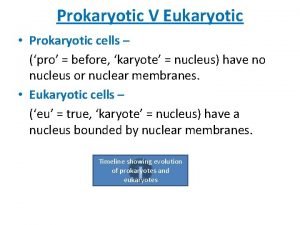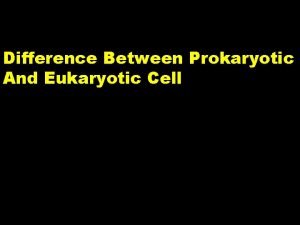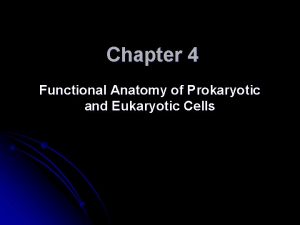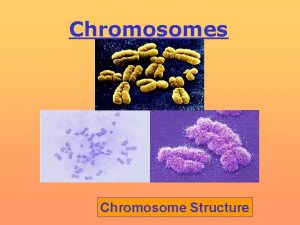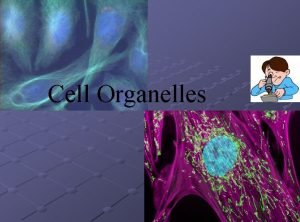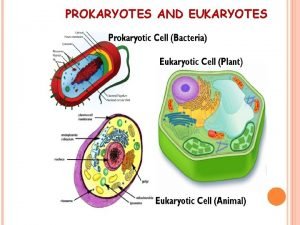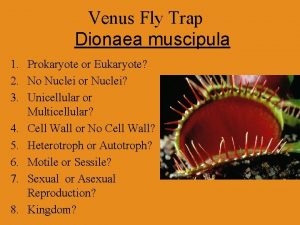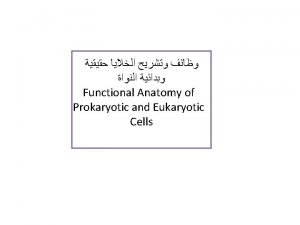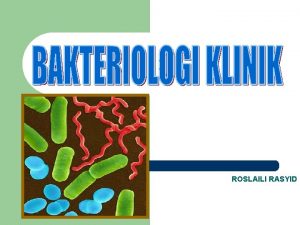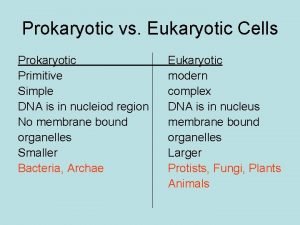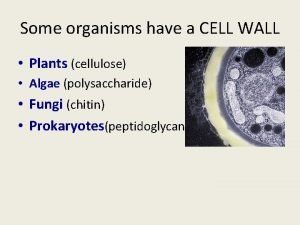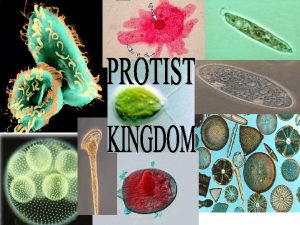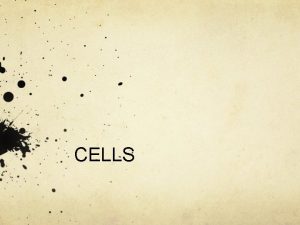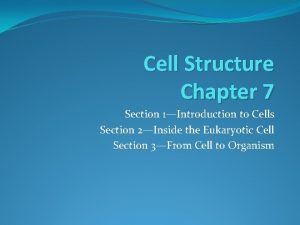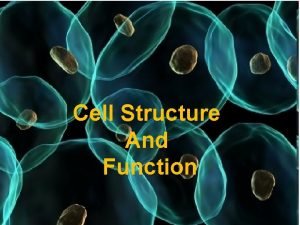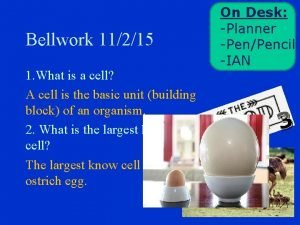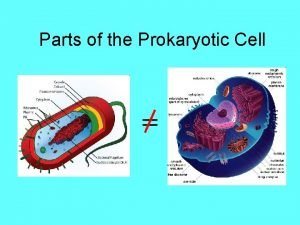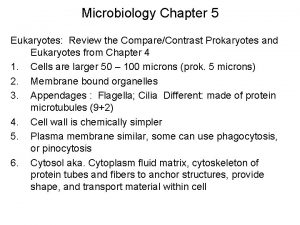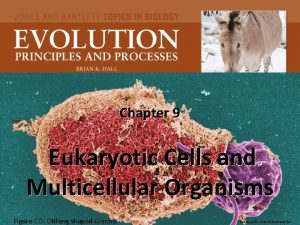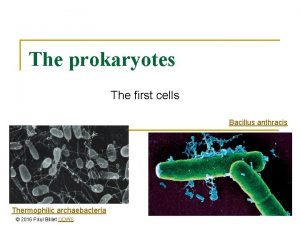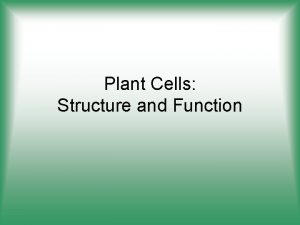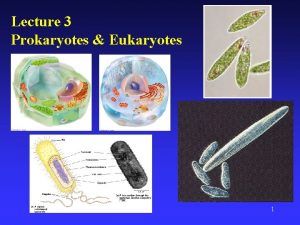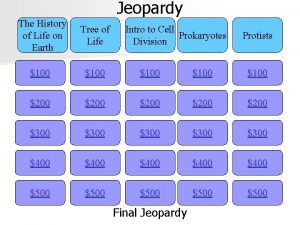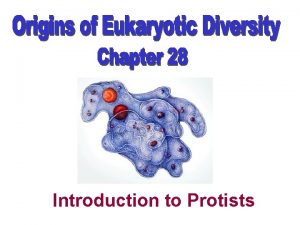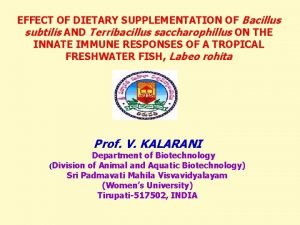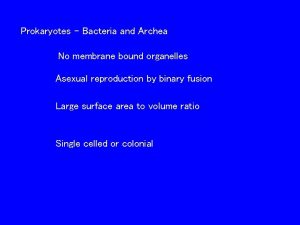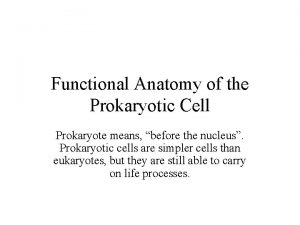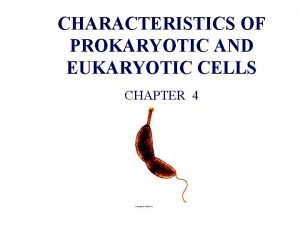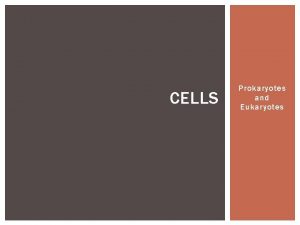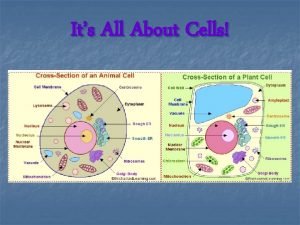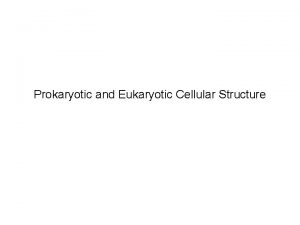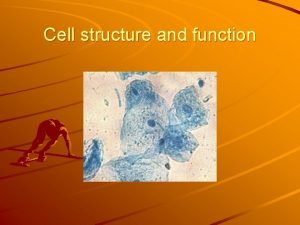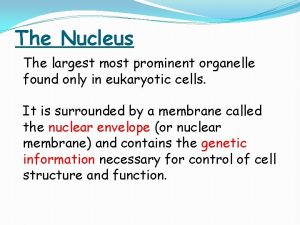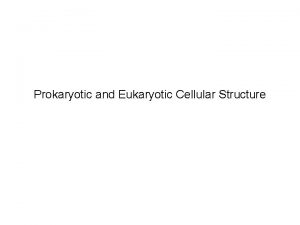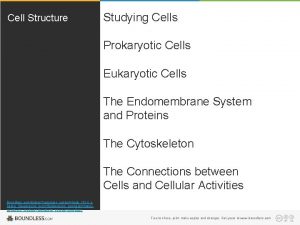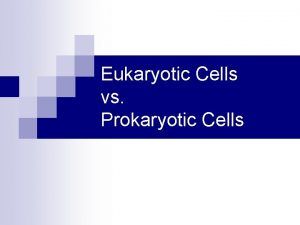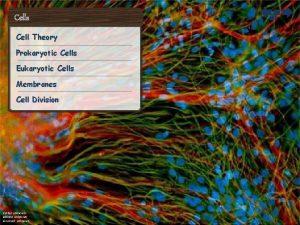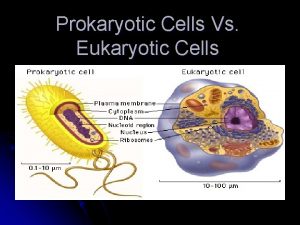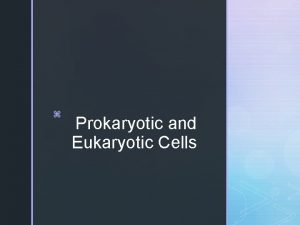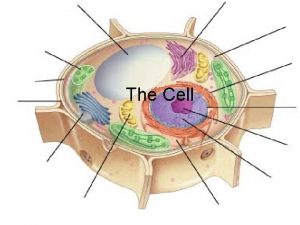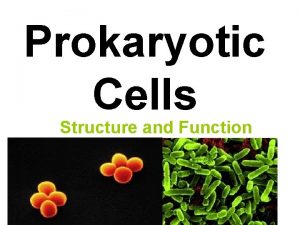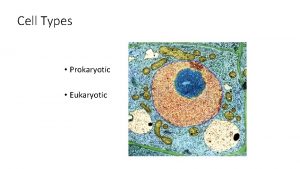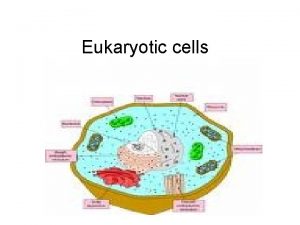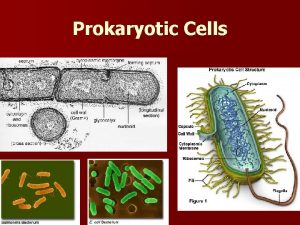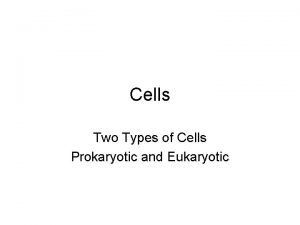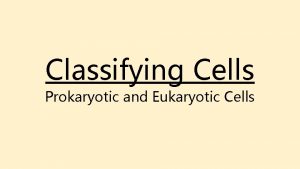Prokaryotic and Eukaryotic Cellular Structure Prokaryotic Eukaryotic Cells



![Prokaryotic & Eukaryotic Cells: An Overview [INSERT FIGURE 3. 1] Prokaryotic & Eukaryotic Cells: An Overview [INSERT FIGURE 3. 1]](https://slidetodoc.com/presentation_image_h/8006efc1c2eef6dc0fb8ccebfabf4653/image-4.jpg)
























































![Cytoplasm of Eukaryotes [INSERT TABLE 3. 5] Cytoplasm of Eukaryotes [INSERT TABLE 3. 5]](https://slidetodoc.com/presentation_image_h/8006efc1c2eef6dc0fb8ccebfabf4653/image-61.jpg)
![Cytoplasm of Eukaryotes [INSERT TABLE 3. 4] Cytoplasm of Eukaryotes [INSERT TABLE 3. 4]](https://slidetodoc.com/presentation_image_h/8006efc1c2eef6dc0fb8ccebfabf4653/image-62.jpg)
![Eukaryotic Cell Walls & Cytoplasmic Membranes [INSERT TABLE 3. 3] Eukaryotic Cell Walls & Cytoplasmic Membranes [INSERT TABLE 3. 3]](https://slidetodoc.com/presentation_image_h/8006efc1c2eef6dc0fb8ccebfabf4653/image-63.jpg)
- Slides: 63

Prokaryotic and Eukaryotic Cellular Structure

Prokaryotic & Eukaryotic Cells: An Overview Prokaryotes Do not have membrane surrounding their DNA lack a nucleus Lack various internal structures bound with phospholipid membranes Are small, ~1. 0 µm in diameter Have a simple structure Composed of bacteria and archaea

Prokaryotic & Eukaryotic Cells: An Overview Eukaryotes Have membrane surrounding their DNA Have a nucleus Have internal membrane-bound organelles Are larger, 10 -100 µm in diameter Have more complex structure Composed of algae, protozoa, fungi, animals, and plants
![Prokaryotic Eukaryotic Cells An Overview INSERT FIGURE 3 1 Prokaryotic & Eukaryotic Cells: An Overview [INSERT FIGURE 3. 1]](https://slidetodoc.com/presentation_image_h/8006efc1c2eef6dc0fb8ccebfabf4653/image-4.jpg)
Prokaryotic & Eukaryotic Cells: An Overview [INSERT FIGURE 3. 1]


Prokaryotic Cell Membrane • Structure – Referred to as phospholipid bilayer; composed of lipids and associated proteins – Approximately half composed of proteins that act as recognition proteins, enzymes, receptors, carriers, or channels • Integral proteins • Peripheral proteins • Glycoproteins – Fluid mosaic model describes current understanding of membrane structure

Cell Membranes contain a hydrophilic and hydrophobic side Composed of many different types of proteins Proteins in the lipid bilayer move freely within the membrane

Thin pliable lipid and protein envelope that defines a cell. Cell Membrane Phospholipid bilayer Functions: • • • Regulates nutrient and water intake Regulates waste removal Site of prokaryotic respiration Site of prokaryotic flagella attachment Involved in the distribution of genetic material during binary fission

Prokaryotic Cytoplasmic Membranes • Function – Energy storage – Harvest light energy in photosynthetic prokaryotes – Selectively permeable – Naturally impermeable to most substances – Proteins allow substances to cross membrane • Occurs by passive or active processes – Maintain concentration and electrical gradient • Chemicals concentrated on one side of the membrane or the other • Voltage exists across the membrane

Cell Membrane


External Structures of Prokaryotic Cells • Glycocalyces – Gelatinous, sticky substance surrounding the outside of the cell – Composed of polysaccharides, polypeptides, or both

External Structures of Prokaryotic Cells • Types of Glycocalyces – Capsule • Composed of organized repeating units of organic chemicals • Firmly attached to cell surface • Protects cells from drying out • May prevent bacteria from being recognized and destroyed by host

Capsule Polysaccharides or polypeptides in composition. Surround the cell wall in some bacteria. Function: • Protection from phagocytosis • Osmotic barrier • Reservoir for nutrients • Virulence factor

Capsule Stain

Slime Layer Consist of polysaccharide fibers that extend form the bacterial surface Functions: • Protection • Attachment • Associated with biofilms

External Structures of Prokaryotic Cells • Types of Glycocalyces – Slime layer • Loosely attached to cell surface • Water soluble • Protects cells from drying out • Sticky layer that allows prokaryotes to attach to surfaces

Bacterial Appendages Flagella Axial Filaments Pili (Fimbriae)

Bacterial Appendages Structures of locomotion Originate in the plasma membrane In bacteria rotate like a propellar Many different arrangements Flagella

External Structures of Prokaryotic Cells • Flagella – Are responsible for movement – Have long structures that extend beyond cell surface – Are not present on all prokaryotes

External Structures of Prokaryotic Cells Flagella Structure Composed of filament, hook, and basal body Flagellin protein (filament) deposited in a helix at the lengthening tip Base of filament inserts into hook Basal body anchors filament and hook to cell wall by a rod and a series of either two or four rings of integral proteins Filament capable of rotating 360º

Bacterial Appendages A. Monotrichous B. Lophotrichous C. Amphitrichous D. Peritrichous Arrangements of Flagella

Bacterial Appendages Axial filament (endoflagella) Originates in the cell membrane and transverses the length of the cell in the periplasmic space. As the endoflagella rotate to move the cell the characteristic shape is formed. Endoflagella are associated with spirochetes.

External Structures of Prokaryotic Cells Endoflagellum is also know as an axial filament. Attached to the plasma embrane and transverses the entire cell. Responsible for the spirochete morphology.

External Structures of Prokaryotic Cells • Flagella – Function • Rotation propels bacterium through environment • Rotation reversible, can be clockwise or counterclockwise • Bacteria move in response to stimuli (taxis) – Runs – Tumbles

Bacterial Appendages • Fimbriae and Pili – Rod-like proteinaceous extensions

Bacterial Appendages Hollow tubes that protrude from some bacteria Compose of protein Fimbriae

External Structures of Prokaryotic Cells • Fimbriae • Sticky, bristlelike projections • Used by bacteria to adhere to one another, to hosts, and to substances in environment • Shorter than flagella • May be hundreds per cell • Serve an important function in biofilms • Virulence factor

External Structures of Prokaryotic Cells • Pili – Tubules composed of pilin – Also known as conjugation pili – Longer than fimbriae but shorter than flagella – Bacteria typically only have one or two per cell – Mediate the transfer of DNA from one cell to another (conjugation)

Bacterial Conjugation Transfer of plasmid DNA from a donor to a recipient. Process strengthens the bacterial cell and alows for survival in a competitive environment.

Bacterial Inclusion Bodies 1. poly-Beta-hydroxybutyric acid - stores lipids for use in plasma membrane 2. glycogen - stores starch like polymer of sugar for energy production 3. Polyphosphate granules (metachromatic granules) - storage for phosphates for plasma membrane and the formation of ATP from ADP. 4. Sulfur granules - stores sulfur which is necessary for the metabolic reactions in biosynthesis.

5. Mesosomes - invagination of the plasma membrane that increases the surfaces area of the plasma membrane during binary fission. The mesosome also serves as a site for the attachment and distribution of genetic material during binary fission.

Mesosome In prokaryotic cell division, called binary fission. A diagram of the attachment of bacterial chromosomes, indicating the possible role of the mesosome (an inward fold of the cell membrane) in ensuring the distribution of the "chromosomes" in a dividing cell. Upon attachment to the plasma membrane, the DNA replicates and reattaches at separate points. Continued growth of the cell gradually separates the chromosomes and allocates chromosome copies to the two daughter cells.

Inclusion Bodies 6. gas vacuoles - storage of metabolic gases such as methane or hydrogen gas. The gas vacuoles help in the buoyancy of the cell and aids in it motility. 7. ribosomes - responsible for the synthesis of proteins. 8. nucleoid material - the genetic material of bacteria, which usually is balled up in the cell. During binary fission the nucleoid material unravels within the cell in order to be copied and distributed to the daughter cells. 9. Plasmid - small fragments of self-replicating extrachromosomal DNA that codes for the resistance to antibiotics or for the productions of a specific metabolite, i. e. toxins, pigments. These plasmids may be transferred from one bacterial cell to another by the F-pili.

Inclusion Bodies 9. Plasmid - small fragments of self-replicating extrachromosomal DNA that codes for the resistance to antibiotics or for the productions of a specific metabolite, i. e. toxins, pigments. These plasmids may be transferred from one bacterial cell to another by the F-pili.

Inclusion Bodies These plasmids may be transferred from one bacterial cell to another by the F-pili.


Inclusion Bodies • Endospores - a survival mechanism of certain genera of bacteria such as Clostridium and Bacillus. The endospores are composed of a complex of dipicolinc acid and calcium and the function of the endospore is to protect the bacterial chromosome. The endospores are very resistant to heat, desiccation, freezing, and other physical properties such as pesticides, antibiotics, dyes, and acids.

Inclusion Bodies The endospores may remain dormant for many years until the environment becomes suitable to sustain the life of the bacteria. The endospore will then germinate to form an exact copy of the parent cell that produced it.



Eukaryotic Cell Walls & Cytoplasmic Membranes • • Fungi, algae, plants, and some protozoa have cell walls but no glycocalyx Composed of various polysaccharides – Cellulose found in plant cell walls – Fungal cell walls composed of cellulose, chitin, and/or glucomannan – Algal cell walls composed of cellulose, proteins, agar, carrageenan, silicates, algin, calcium carbonate, or a combination of these

Cell Walls Three different types of cell walls and their compositions: Fungal cell walls are composed of cellulose and/or chitin. Plant cell walls are composed of cellulose. Algal cell walls are composed of cellulose, silicon, and calcium carbonate.

Plasma Membrane Consist of a lipid bilayer and associated proteins. The Plasma Membrane of Eukaryotic cells resembles and functions in the same manner as the prokaryotic plasma membrane with the following exceptions; Contains high levels of sterols such as cholesterol. No respiratory enzymes are located in the eukaryotic plasma membrane. Respiration occurs in the mitochondria.

External Structure of Eukaryotic Cells • Glycocalyces – Never as organized as prokaryotic capsules – Help anchor animal cells to each other – Strengthen cell surface – Provide protection against dehydration – Function in cell-to-cell recognition and communication

Eukaryotic Appendages Flagella There are several different arrangements of flagella in eucaryotes. This diagram represents a biflagellated eukaryotic cell. One of the flagella aids in movement laterally and the other aids in up and down movement. The eukaryotic flagella move like a whip. See Flagellar handout.

Eukaryotic Appendages • Flagella – Function • Do not rotate, but undulate rhythmically

Eukaryotic Appendages Cilia Similar to flagella both structurally and functionally but are much shorter and more numerous. Cilia are found peritrichously to the cell. Move in an undulating manner and motility by those organisms with cilia is much more rapid than those with flagella.


Intracellular Structures of Eukaryotic Organisms (organelles) Membranous Organelles Nucleus Often largest organelle in cell Contains most of the cell’s DNA Semi-liquid portion called nucleoplasm One or more nucleoli present in nucleoplasm; RNA synthesized in nucleoli Nucleoplasm contains chromatin – masses of DNA associated with histones Surrounded by nuclear envelope – double membrane composed of two phospholipid bilayers Nuclear envelope contains nuclear pores

Intracellular Structures of Eukaryotic Organisms (organelles) Nucleus - double membraned organelle that houses the genetic material of cell. Nuclear membrane contains numerous pores through which proteins and RNA can move.

Intracellular Structures of Eukaryotic Organisms (organelles) Membranous Organelles Endoplasmic reticulum Netlike arrangement of flattened, hollow tubules continuous with nuclear envelope Functions as transport system Two forms Smooth endoplasmic reticulum (SER) – plays role in lipid synthesis Rough endoplasmic reticulum (RER) – ribosomes attached to its outer surface; transports proteins produced by ribosomes

Intracellular Structures of Eukaryotic Organisms (organelles) Endoplasmic reticulum - network of cytoplasmic membranes where lipids and proteins are produced. Smooth ER - synthesis of lipids Rough ER - associated with ribosomes and is responsible for the synthesis of proteins. .

Intracellular Structures of Eukaryotic Organisms (organelles) Membranous Organelles Golgi body Receives, processes, and packages large molecules for export from cell Packages molecules in secretory vesicles that fuse with cytoplasmic membrane Composed of flattened hollow sacs surrounded by phospholipid bilayer Not in all eukaryotic cells

Intracellular Structures of Eukaryotic Organisms (organelles) Golgi apparatus (dictyosome) is associated with the ER. It modifies and packages the lipids and proteins manufactured by the ER and places them in vesicles for cellular use.

Intracellular Structures of Eukaryotic Organisms (organelles) • Membranous Organelles – Lysosomes, peroxisomes, vacuoles, and vesicles • Store and transfer chemicals within cells • May store nutrients in cell • Lysosomes contain catabolic enzymes • Peroxisomes contain enzymes that degrade poisonous wastes

Intracellular Structures of Eukaryotic Organisms (organelles) • Membranous Organelles – Mitochondria • Have two membranes composed of phospholipid bilayer • Produce most of cell’s ATP • Interior matrix contains 70 S ribosomes and circular molecule of DNA

Intracellular Structures of Eukaryotic Organisms (organelles) mitochondria - involved in the production of chemical energy in the form of ATP. Consist of convoluted inner membrane and outer membrane. Invaginations are called cristae and contain enzymes used to synthesis ATP. All respiratory enzymes are located in the inner membrane of the mitochondria.

Cytoplasm of Eukaryotes • Membranous Organelles – Chloroplasts • Light-harvesting structures found in photosynthetic eukaryotes • Have two phospholipid bilayer membranes and DNA • Have 70 S ribosomes

Cytoplasm of Eukaryotes • Endosymbiotic Theory – Eukaryotes formed from union of small aerobic prokaryotes with larger anaerobic prokaryotes – smaller prokaryotes became internal parasites • Parasites lost ability to exist independently; retained portion of DNA, ribosomes, and cytoplasmic membranes • Larger cell became dependent on parasites for aerobic ATP production • Aerobic prokaryotes evolved into mitochondria • Similar scenario for origin of chloroplasts – Not universally accepted
![Cytoplasm of Eukaryotes INSERT TABLE 3 5 Cytoplasm of Eukaryotes [INSERT TABLE 3. 5]](https://slidetodoc.com/presentation_image_h/8006efc1c2eef6dc0fb8ccebfabf4653/image-61.jpg)
Cytoplasm of Eukaryotes [INSERT TABLE 3. 5]
![Cytoplasm of Eukaryotes INSERT TABLE 3 4 Cytoplasm of Eukaryotes [INSERT TABLE 3. 4]](https://slidetodoc.com/presentation_image_h/8006efc1c2eef6dc0fb8ccebfabf4653/image-62.jpg)
Cytoplasm of Eukaryotes [INSERT TABLE 3. 4]
![Eukaryotic Cell Walls Cytoplasmic Membranes INSERT TABLE 3 3 Eukaryotic Cell Walls & Cytoplasmic Membranes [INSERT TABLE 3. 3]](https://slidetodoc.com/presentation_image_h/8006efc1c2eef6dc0fb8ccebfabf4653/image-63.jpg)
Eukaryotic Cell Walls & Cytoplasmic Membranes [INSERT TABLE 3. 3]
 What is eukarya
What is eukarya Prokaryotic vs eukaryotic cells venn diagram
Prokaryotic vs eukaryotic cells venn diagram What cell type
What cell type Is a staphylococcus cell prokaryotic or eukaryotic
Is a staphylococcus cell prokaryotic or eukaryotic 3 parts of cell theory
3 parts of cell theory Cytoskeletal protein
Cytoskeletal protein Similarity between prokaryotic and eukaryotic cells
Similarity between prokaryotic and eukaryotic cells Comparison of prokaryotic and eukaryotic cells
Comparison of prokaryotic and eukaryotic cells Prokaryotes vs eukaryotes chart
Prokaryotes vs eukaryotes chart Difference between prokaryotic and eukaryotic cell
Difference between prokaryotic and eukaryotic cell How water moves
How water moves Difference between prokaryotic and eukaryotic cells
Difference between prokaryotic and eukaryotic cells Prokaryotic cell and eukaryotic cell similarities
Prokaryotic cell and eukaryotic cell similarities Anatomy of prokaryotes and eukaryotes
Anatomy of prokaryotes and eukaryotes Nondisjunction in meiosis
Nondisjunction in meiosis How to read chromosome
How to read chromosome Prokaryotic and eukaryotic venn diagram
Prokaryotic and eukaryotic venn diagram Prokaryotic and eukaryotic venn diagram
Prokaryotic and eukaryotic venn diagram Cytoskeleton prokaryotic or eukaryotic
Cytoskeleton prokaryotic or eukaryotic The oldest prokaryote is/are:
The oldest prokaryote is/are: Prokaryotic cell and eukaryotic cell
Prokaryotic cell and eukaryotic cell Venus fly trap prokaryotic or eukaryotic
Venus fly trap prokaryotic or eukaryotic Site:slidetodoc.com
Site:slidetodoc.com Monera procariota
Monera procariota Is protozoa prokaryotic or eukaryotic
Is protozoa prokaryotic or eukaryotic Is bacteria prokaryotic or eukaryotic
Is bacteria prokaryotic or eukaryotic Is an amoeba a prokaryote
Is an amoeba a prokaryote Prokaryote multicellular
Prokaryote multicellular Prokaryotic vs eukaryotic
Prokaryotic vs eukaryotic Manitole
Manitole Lipshutz bodies
Lipshutz bodies Is animalia prokaryotic or eukaryotic
Is animalia prokaryotic or eukaryotic Eukaryotic cell
Eukaryotic cell Wine roots servian
Wine roots servian Protists have nucleus
Protists have nucleus Staphylococcus prokaryotic or eukaryotic
Staphylococcus prokaryotic or eukaryotic Cytoskeleton prokaryotic or eukaryotic
Cytoskeleton prokaryotic or eukaryotic Food vacuole eukaryotic or prokaryotic
Food vacuole eukaryotic or prokaryotic Staphylococcus prokaryotic or eukaryotic
Staphylococcus prokaryotic or eukaryotic Www.brainpopcom
Www.brainpopcom Amoeba prokaryotic or eukaryotic
Amoeba prokaryotic or eukaryotic Is green algae prokaryotic or eukaryotic
Is green algae prokaryotic or eukaryotic Mitochondria double membrane function
Mitochondria double membrane function Domain monera
Domain monera Green algae supergroup
Green algae supergroup Are earthworms eukaryotic or prokaryotic
Are earthworms eukaryotic or prokaryotic Bacillus anthracis prokaryotic or eukaryotic
Bacillus anthracis prokaryotic or eukaryotic Prokaryotic cell
Prokaryotic cell Eukaryotic plant cell
Eukaryotic plant cell Axial filament
Axial filament Anggota kingdom monera
Anggota kingdom monera Are algae eukaryotic or prokaryotic
Are algae eukaryotic or prokaryotic Endosymbiosis
Endosymbiosis Parenchymatous algae
Parenchymatous algae Bacillus subtilis prokaryotic or eukaryotic
Bacillus subtilis prokaryotic or eukaryotic Are bacteria prokaryotic or eukaryotic
Are bacteria prokaryotic or eukaryotic What time did you arrive in class today
What time did you arrive in class today The characteristics of prokaryotic cells
The characteristics of prokaryotic cells Characteristics of prokaryotic cells
Characteristics of prokaryotic cells Domains of prokaryotic cells
Domains of prokaryotic cells Are chromosomes living or nonliving
Are chromosomes living or nonliving Membranous organelles
Membranous organelles Prokaryotic cells lack
Prokaryotic cells lack Most prominent organelle in eukaryotic cells
Most prominent organelle in eukaryotic cells









